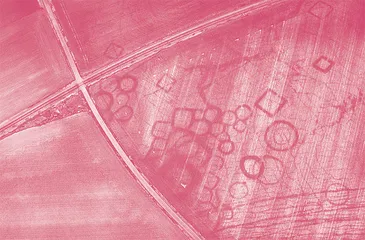Unexpected Things About Archaeology考古出乎意料的几件事
作者: 伦敦考古博物馆团队 孟洁冰译

Archaeology is an amazing career. We get to explore and debate how life has been and can be lived, and we get to share this knowledge with people in a way which benefits society.
考古是一项了不起的事业。我们可以研究和讨论人类过去的生活方式与可能的生活状态,还可以与人们分享这些知识,从而使社会受益。
If you don’t know an archaeologist or haven’t worked with one before, you might not know what they actually do or you might think we do things that we don’t.
如果你不了解考古学家,以前也没有和他们一起工作过,那你可能不知道他们到底都做些什么,也许对考古学家的工作内容有所误解。
So we thought we would pull together a list of things you might not know about archaeology:
因此,我们想整理一份清单,让大家了解可能不知道的关于考古的一些事:
1. Not all archaeology is underground
1. 不是所有的考古工作都在地下
A lot of people think of archaeology as being buried in the ground, but any physical material can tell us about the past. This means above-ground remains, like buildings, are important forms of evidence. In fact, there’s a whole specialism of archaeology that involves recording historic buildings and creating drawings and reports about them.
很多人以为考古就是发掘埋在地下的东西,但只要是实物材料,都可以让我们了解历史。这意味着地面上的遗迹(比如建筑物)也是重要的考古证据。实际上,考古学有一个完整的专业门类,涉及记录历史建筑物、绘制建筑图纸和撰写相关报告。
2. Archaeologists usually have a good idea of what they’ll find before they start digging
2. 考古学家通常在开始挖掘前就知道会发现什么
Archaeologists get more information about the history of an area with every site they dig. Combining this with historical records, such as maps, helps them predict what will be on a new site. They can estimate how deep underground the archaeology will be found and how well it will be preserved.
考古学家每挖掘一处遗址,都会了解关于该地区历史的更多信息。他们把这些信息与地图等历史文献结合起来,这样做有助于预测在新的遗址会有什么发现。他们可以估计在地下多深的地方有考古发现,以及遗迹的保存情况。
There are still surprises. In 2018, when digging along the River Thames for Tideway’s new super sewer, MOLA found the skeleton of a medieval man face down in the mud, still wearing knee-high leather boots.
不过仍然会有意外收获。2018年,泰晤士河潮汐道新的超级下水项目进行沿河挖掘工作时,伦敦考古博物馆发现了一具中世纪男性的骨骸,他脸朝下倒在泥泞中,所穿的齐膝皮靴仍然保存完好。
3. Archaeologists aren’t only interested in gold
3. 考古学家不是仅对黄金感兴趣
You might think archaeologists are only interested in the most precious items, like coins, gold jewellery or well-preserved objects. But often the most common items—like pottery, clay tobacco pipes, glass bottles or bricks—can tell them the most information. They help build a picture of people’s lives. Sometimes, not finding an object we thought would be there tells us something about the people.
你可能认为考古学家只对最珍贵的文物感兴趣,比如硬币、黄金首饰或保存完好的器物。但往往最普通的文物——比如陶器、黏土烟斗、玻璃瓶或砖块——可能向考古学家透露最多的信息。这些文物有助于构建人们生活的场景。有时候,没找到事先认为会存在的文物也会透露关于古人的一些情况。
Archaeologists don’t always dig in exciting places either. They are more likely to work in a car park in Leicester than by the pyramids in Egypt. But that car park might just contain the grave of a king of England.
考古学家的发掘现场也不总是令人激动的地方。他们更有可能在莱斯特的某个停车场而不是埃及的金字塔旁工作,不过那个停车场可能刚好是一位英格兰国王的墓地所在。
4. Dinosaurs aren’t involved in archaeology
4. 恐龙与考古学无关
Archaeology is the study of human history through physical objects and other evidence left behind. This doesn’t include dinosaurs because they were on Earth more than 58 million years before our first human ancestors.
考古学是利用遗留下来的实物和其他证据来研究人类历史的学问。这项研究不包括恐龙,因为恐龙在地球上生存的时间比我们最早的人类祖先还要早5800万年。
But palaeontology (the study of dinosaurs) uses similar methods to archaeology. These include digging in layers and making careful records.
不过,对恐龙进行研究的古生物学使用的方法与考古学有相似之处,包括分层挖掘和制作详细记录。
5. Archaeologists don’t use brushes very often
5. 考古学家不经常使用刷子
Many people think archaeologists spend all day brushing dirt off the items they find. They do sometimes use brushes to clean surfaces for clear photographs. But they mainly use tools like trowels, shovels or mattocks (pickaxes with flat blades). A normal day involves a lot of heavy digging. They also must work quickly as they are usually part of a wider construction project.
许多人认为考古学家整天都在给发现的文物刷去尘土。为了拍摄清晰的图片,考古学家有时的确会用刷子清理文物的表面。但是,他们工作时主要使用的是镘刀、铲子或鹤嘴锄(平刃镐)等工具。正常情况下,每天需要进行大量的挖掘工作。考古学家还必须快速推进工作,因为他们的工作通常涉及范围更广的建筑项目。
Sometimes archaeologists work with very fragile items. For this they would normally use tools like a thin ‘leaf’ trowel—but rarely a brush.
考古学家有时需要处理非常易碎的文物,对此他们通常会使用很薄的“尖头铲”这样的工具——极少用刷子。
6. Archaeologists can use technology to learn what is underground instead of digging
6. 考古学家可以利用技术而非挖掘来了解地下的情况
Archaeologists don’t have to dig to learn about what is underground. Geophysical survey uses electric and magnets to find tiny differences in the earth and creates a map of potential archaeology underneath. Drones can also be used to take aerial photographs, where things like cropmarks can be clues to past human activity. MOLA used both of these at Borough Hill in Daventry.
考古学家并非只能通过挖掘来了解地下的情况。地球物理勘测可以利用电和磁体来找出泥土的微小差异,创建可能存在的考古遗址的地图。无人机也可用于航拍,拍到的像“作物标记”这样的神秘图形可能就是过去人类活动的线索。伦敦考古博物馆在达文特里伯勒山的考古中就采用了这两种方法。
7. Indiana Jones was a bad archaeologist